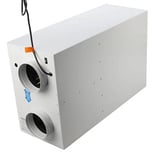 A study commissioned by Second Nature, the nation’s largest home wellness subscription service, revealed that 99 percent of Americans want a healthy home, yet 62 percent say they could do a better job of obtaining one. One of the major ways that homeowners can ensure a healthy home is maintaining good indoor air quality (IAQ). The U.S. Environmental Protection Agency (EPA) estimates[1] that indoor air is up to five times more polluted than outdoor air, an alarming fact that is likely to heighten consumer concerns.
A study commissioned by Second Nature, the nation’s largest home wellness subscription service, revealed that 99 percent of Americans want a healthy home, yet 62 percent say they could do a better job of obtaining one. One of the major ways that homeowners can ensure a healthy home is maintaining good indoor air quality (IAQ). The U.S. Environmental Protection Agency (EPA) estimates[1] that indoor air is up to five times more polluted than outdoor air, an alarming fact that is likely to heighten consumer concerns.
The combination of tighter homes and more pollutants is driving builder utilization of mechanical ventilation and in some cases, air purification, in new construction homes. And this development will benefit consumers who are interested in cleaner, fresher indoor air and home builders leveraging the “healthy home” trend.
Fresher Air in New Homes
More stringent energy efficiency codes are good for home buyers, but without proper ventilation, a home that is fully air sealed and insulated will trap in harmful pollutants, such as carbon monoxide and moisture, which can lead to mold growth, ruin insulation, and could even lead to structural degradation.
Joseph Hillenmeyer, channel marketing manager for residential new construction at Aprilaire, says that while newer, tighter home designs are doing wonders for energy efficiency, overlooking ventilation in those airtight homes can potentially become very unhealthy and uncomfortable for occupants.
“Building codes have taken notice of this and are driving more strict ventilation standards. The desire by many builders to provide a differentiated healthy home to their customers is also creating demand for mechanical ventilation in new construction.”
Hillenmeyer talked about the several ventilation options for builders.
Basic Level: Exhaust Ventilation
According to Hillenmeyer, the most commonly used method of ventilation today is the simple exhaust ventilation (such as a bath fan). It is the most economical solution available. However, the industry is learning that it is not the best solution for proper whole-home ventilation. “These ‘exhaust only’ fans are good for spot ventilation, for example in bathrooms or over ranges.” But, exhaust only fans create negative pressure in a home, which is the result of more air leaving the interior of the home than is being replenished from outside. This can result in poor indoor air quality, increased radon levels, and carbon monoxide poisoning.[2]
Bonus Level: Supply Ventilation
The second-most popular method of ventilation is supply ventilation. This method distributes ventilation air throughout the home and creates positive pressure in the building. Supply ventilation allows for better control of the air that moves in the house. It allows outdoor air to be filtered (to remove dust and pollutants) or dehumidified, which is very important in high-humidity climates or during high-humidity periods.
Bonus+: Balanced Ventilation
A third type of ventilation balances the exhaust and supply methods, providing equal indoor exhaust and outdoor supply air flows. This type of ventilation system could include a heat recovery ventilator (HRV) or an Energy Recovery Ventilator (ERV). HRVs and ERVs are similar in that both supply air to the home and exhaust stale air while recovering energy from the exhaust air in the process. The main difference between the two is that an HRV transfers heat while an ERV transfers both heat and moisture.
HRVs and ERVs provide the benefits but reduce the drawbacks of supply-only and exhaust only methods. Also, typically and HRV is recommended for dry, cold climates and an ERV for moist, warm climates. Both have the highest installed costs of the ventilation systems due to equipment and ducting costs.
Beyond Ventilation: Adding Purification
Aprilaire recommends mechanical ventilation and whole-house air purification to deliver a healthy home with acceptable IAQ. “With new materials and designs, home construction today is so tight that any new home should have mechanical ventilation. Our primary recommendation is supply ventilation due to cost and ease of installation,” said Hillenmeyer. “With the right control strategy, supply ventilation can be energy efficient and effective.”
“But ventilation is only one part of optimizing indoor air quality. It’s also important to purify the indoor air to remove contaminants. Controlling fresh air ventilation provides the best solution to reduce possible pollutants, such as VOCs, cook smoke, and other contaminants in the home, not only when it’s new, but for the life of the home.”
Leveraging Healthy Home Messaging
Builders who leverage “healthy home” marketing are emphasizing IAQ as a significant differentiator to their potential buyers. “When a builder takes this path, they typically present the benefits of not only proper ventilation but also air cleaning (purification) and humidity control to consumers. They are educating the home buyer on all the elements that make up IAQ and how to properly control them. This is becoming easier each year as new smart solutions for monitoring and intuitively controlling IAQ become available,” noted Hillenmeyer. “Consumers are more aware of the issues that arise in new, tightly built homes and are looking for solutions. Builders are now responding to that by providing the information consumers want about maintaining a healthy home, and that’s been a major improvement recently.”
[1] https://www.epa.gov/report-environment/indoor-air-quality
[2] https://www.cwsuter.com/negative-air-pressure-symptoms-dangers-solutions/





